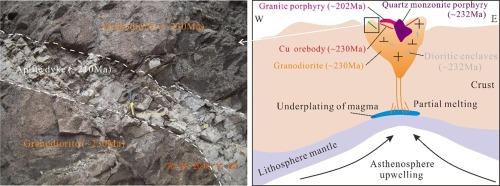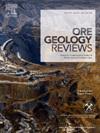Geology and mineralization of the Yangla polymetallic orefield in northwestern Yunnan, SW China: Age, petrogenesis and rare-metal metallogenic implications of aplite dykes
IF 3.2
2区 地球科学
Q1 GEOLOGY
引用次数: 0
Abstract
Aplite dykes commonly represent more evolved magma and are closely associated with rare metal mineralization. However, the multiphase magmatism and rare metal mineralization of aplite dykes in the Yangla orefield have not been well-constrained. Here, we present new data on the Linong aplite dykes and the associated Jiangbian granodiorite in the Yangla orefield, including data of zircon U-Pb age and Hf isotopes, and lithogeochemistry and Pb-Sr-Nd isotopes, in order to elucidate their emplacement age, petrogenesis, and rare metal mineralization potential. The three aplite dykes studied were emplaced at 214.3 ± 5.1 Ma, 209.2 ± 5.2 Ma, and 205.5 ± 3.4 Ma. These Late Triassic aplite dykes have high SiO2 (75.81–76.94 wt%) and K2O (avg. 5.60 wt%) and are peralkaline–metaluminous (A/CNK = 0.86–0.93). They have high whole-rock (87Sr/86Sr)i (0.6947–0.7094), εNd(t) (−6.26 to − 5.77), (206Pb/204Pb)t = 18.365–18.804, (207Pb/204Pb)t = 15.688–15.715, (208Pb/204Pb)t = 38.436–38.681, and zircon εHf(t) = − 8.10 to + 1.62. The Triassic (208–228 Ma) Jiangbian granodiorite is high-K calc-alkaline, metaluminous/weakly peraluminous (A/CNK = 0.52–1.19) with high Al2O3 (12.49–16.74 wt%). They have high (87Sr/86Sr)i (0.7075–0.7102), whole-rock εNd(t) (−6.12 to − 5.88), (206Pb/204Pb)t = 18.155–18.384, (207Pb/204Pb)t = 15.665–15.698, (208Pb/204Pb)t = 38.579–38.719, and zircon εHf(t) = − 4.20 to + 2.40. These geochemical features imply that both the aplite dykes and granodiorite have their primary magma derived from partial melting of the Proterozoic basement, with minor mantle input. The aplite samples have an average estimated crystallization temperature of 712 ℃, and relatively low magmatic oxygen fugacity ([log(fo2)] = − 21.98 to – 5.48, avg. = –17.05), which are slightly higher than that of most Triassic granitoids in the Yangla orefield. The result shows that the crystallization temperature and oxygen fugacity gradually increase, while the 176Hf/177Hf and εHf(t) gradually decrease. Our new and published geochemical data from the Yangla granitoids reveal that the aplite dykes and granodiorite were formed in a post-collisional setting. Whole-rock Nb/Ta, Zr/Hf, Rb/Sr, Ba/Rb, and zircon REE features of the aplite dykes highly mimic those of typical Sn-W related granites, suggesting certain Sn-W rare metals mineralization potential in the Yangla orefield.

中国西南部云南西北部羊拉多金属矿区的地质与矿化:辉绿岩岩体的年龄、成岩学和稀有金属成矿意义
闪长岩岩体通常代表了演化程度较高的岩浆,与稀有金属矿化密切相关。然而,阳拉矿田中的闪长岩堤的多相岩浆作用和稀有金属成矿作用还没有得到很好的约束。在此,我们提供了关于羊拉矿田临农闪长岩堤和相关江边花岗闪长岩的新数据,包括锆石U-Pb年龄和Hf同位素数据、岩石地球化学和Pb-Sr-Nd同位素数据,以阐明它们的成岩年龄、成岩作用和稀有金属成矿潜力。所研究的三个辉长岩堤的成岩年代分别为 214.3 ± 5.1 Ma、209.2 ± 5.2 Ma 和 205.5 ± 3.4 Ma。这些晚三叠世的辉长岩岩体具有较高的二氧化硅(75.81-76.94 wt%)和氧化钾(平均 5.60 wt%)含量,并且是近铝-近铝(A/CNK = 0.86-0.93)。它们具有较高的全岩 (87Sr/86Sr)i (0.6947-0.7094)、εNd(t) (-6.26 to - 5.77)、(206Pb/204Pb)t = 18.365-18.804, (207Pb/204Pb)t = 15.688-15.715, (208Pb/204Pb)t = 38.436-38.681, 以及锆石 εHf(t) = - 8.10 to + 1.62。三叠纪(208-228 Ma)江边花岗闪长岩为高K钙碱性、金属铝/弱过铝(A/CNK = 0.52-1.19)、高Al2O3(12.49-16.74 wt%)。它们具有较高的(87Sr/86Sr)i(0.7075-0.7102)、全岩εNd(t)(-6.12至-5.88)、(206Pb/204Pb)t=18.155-18.384、(207Pb/204Pb)t=15.665-15.698、(208Pb/204Pb)t=38.579-38.719和锆石εHf(t)=-4.20至+2.40。这些地球化学特征表明,辉长岩堤和花岗闪长岩的主要岩浆来自新生代基底的部分熔融,少量地幔输入。阳起岩样品的平均结晶温度估计为 712 ℃,岩浆氧富集度相对较低([log(fo2)] = - 21.98 至 - 5.48,平均 = -17.05),略高于羊拉矿区大部分三叠纪花岗岩的结晶温度。结果表明,结晶温度和氧富集度逐渐升高,而176Hf/177Hf和εHf(t)逐渐降低。我们新公布的羊拉花岗岩地球化学数据显示,阳起岩堤和花岗闪长岩是在碰撞后环境中形成的。闪长岩岩体的全岩Nb/Ta、Zr/Hf、Rb/Sr、Ba/Rb和锆石REE特征与典型的Sn-W相关花岗岩特征高度相似,表明羊拉矿区具有一定的Sn-W稀有金属成矿潜力。
本文章由计算机程序翻译,如有差异,请以英文原文为准。
求助全文
约1分钟内获得全文
求助全文
来源期刊

Ore Geology Reviews
地学-地质学
CiteScore
6.50
自引率
27.30%
发文量
546
审稿时长
22.9 weeks
期刊介绍:
Ore Geology Reviews aims to familiarize all earth scientists with recent advances in a number of interconnected disciplines related to the study of, and search for, ore deposits. The reviews range from brief to longer contributions, but the journal preferentially publishes manuscripts that fill the niche between the commonly shorter journal articles and the comprehensive book coverages, and thus has a special appeal to many authors and readers.
 求助内容:
求助内容: 应助结果提醒方式:
应助结果提醒方式:


